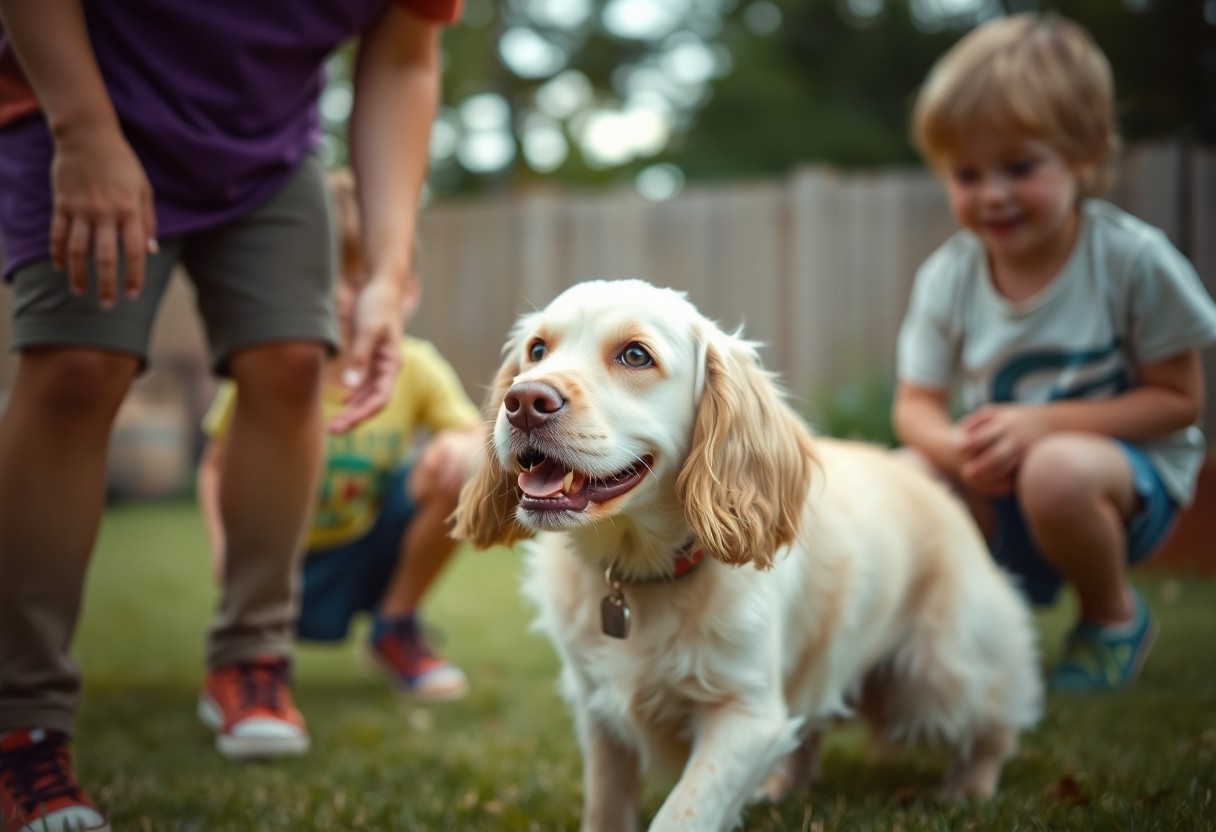Clumber Spaniels are known for their gentle and affectionate nature, making them a great choice for families looking for a loyal companion. If you’re considering adding a Clumber to your household, you’ll appreciate their calm demeanor and playful spirit, which often makes them excellent with children. However, it’s crucial to provide them with proper training and socialization to ensure they thrive. For more insights from fellow pet owners, check out this Clumber Spaniel – Pet Forums discussion.
Key Takeaways:
- Clumber Spaniels are known for their gentle and affectionate nature, making them great companions for families.
- They are generally good with children, displaying patience and a playful attitude that can enhance family dynamics.
- This breed is sociable and tends to get along well with other pets, including dogs and cats.
- Clumber Spaniels require regular exercise and mental stimulation to thrive, which can encourage active family involvement.
- Due to their friendly disposition, Clumber Spaniels may not make ideal guard dogs, as they are more inclined to welcome strangers.
- Early socialization and training are beneficial for helping them develop good behavior and adapt to family life.
- They have a moderate energy level, making them suitable for families with varying activity levels, but they still need routine engagement.
Overview of Clumber Spaniels
For those considering a Clumber Spaniel, you’ll find a breed that is known for its gentle and affectionate nature. These dogs are typically easygoing, making them well-suited for families. With their loyal disposition, they often become devoted companions, thriving in a loving home where they can enjoy interaction and activity with their family members.
History and Origin
History traces the Clumber Spaniel’s roots back to the 18th century in England. Originally bred as a hunting dog for game, they were favored by nobility and known for their stamina in the field. Over time, Clumber Spaniels evolved to become more than just hunting companions; they grew into beloved family pets, maintaining their friendly demeanor and strong work ethic.
Physical Characteristics
For those curious about the Clumber Spaniel’s appearance, these dogs are large, strong, and sturdy. They typically weigh between 55-85 pounds and have a distinctive appearance with a broad head, short legs, and soft, wavy coat that comes in different shades of white with orange or lemon markings. Their eyes are expressive and often convey a gentle nature, making them even more endearing.
It is also worth noting that Clumber Spaniels possess a strong build, which can lead to certain health concerns like hip dysplasia and ear infections. Their wavy coat requires regular grooming to prevent matting and maintain hygiene. When considering a Clumber Spaniel, be prepared to invest time in their exercise and mental stimulation needs to ensure a happy and healthy life for your furry friend.
Temperament Traits
Some of the defining temperament traits of the Clumber Spaniel include their gentle nature, friendly disposition, and a mellow attitude that makes them well-suited for family life. Their calm demeanor is complemented by an intelligent and eager-to-please personality, making training a rewarding experience. For more insights on their health and care, you can visit Clumber Spaniel Dog Breed Health and Care.
General Temperament
At their core, Clumber Spaniels are affectionate and loyal companions. With a love for human interaction, they thrive in environments where they can spend quality time with their families. Their laid-back personality makes them excellent pets for both active households and those seeking a quieter companion.
Interaction with Children
Interaction with children is where Clumber Spaniels truly shine, as they are naturally gentle and protective of younger family members. These dogs possess the patience to handle the rambunctiousness of kids while also sharing a fun-loving spirit. Consequently, Clumber Spaniels tend to form strong bonds with children, displaying an innate tolerance for playful antics and affection. As long as proper introductions and boundaries are established, their friendly temperament ensures they can be safe and happy cohabitants with children, making them a fantastic family dog choice.
Socialization Needs
Your Clumber Spaniel’s temperament greatly benefits from proper socialization. Engaging with different people, environments, and other animals is important in shaping a well-rounded dog. For insights, check out this [Discussion] honest commentary from Clumber spaniel …. Regular exposure helps reduce anxiety and promotes friendliness, making them more adaptable family companions.
Early Socialization
Below, ensure your Clumber Spaniel experiences various sights, sounds, and interactions early on. Starting this process between 3 to 14 weeks sets the foundation for a confident and well-adjusted dog. Early socialization can minimize the likelihood of behavioral issues later in life.
Compatibility with Other Pets
Against common belief, Clumber Spaniels can be excellent companions for other pets if socialized correctly from a young age. With consistent training and early introductions to different animals, they can coexist with cats and small pets. However, supervision is vital during initial interactions to avoid any misunderstandings. Their gentle nature often endears them to other friendly pets, but always keep in mind that every dog is an individual. Start with positive reinforcement techniques to encourage harmonious relationships and help your Clumber Spaniel thrive in a multi-pet household.
Training Considerations
Many factors influence the training of Clumber Spaniels, including their temperament and intelligence. These dogs are generally eager to please, making them receptive to training. However, you should be patient and consistent, as they may show stubbornness at times. Start training early, and ensure it’s a positive experience to build a strong bond with your furry companion.
Training Techniques
An effective training approach for Clumber Spaniels combines positive reinforcement with clear commands. Utilize treats and praise to motivate your dog, and be sure to keep training sessions short and engaging. Consistency is key; using the same commands will help your dog learn faster and maintain focus during sessions.
Behavioral Challenges
Training Clumber Spaniels may present some behavioral challenges. Strong-willed and occasionally independent, they may test your boundaries. Barking, digging, and excessive chewing can be common issues, especially if they become bored. Address these behaviors promptly with positive reinforcement techniques to encourage desirable habits and help your dog thrive in a family environment.
And, addressing behavioral challenges involves understanding the root cause of the issues your Clumber may exhibit. Often, they stem from insufficient exercise or mental stimulation, leading to boredom and frustration. Regular walks, engaging activities, and structured play can significantly reduce unwanted behaviors. Always be proactive and focus on redirecting your dog’s energy toward wholesome behaviors rather than letting them develop into serious problems.
Exercise and Activity Level
Despite their laid-back appearance, Clumber Spaniels require regular exercise to maintain optimal health and happiness. These dogs have a moderate energy level, which means they benefit from a balanced routine of physical activities to keep them engaged. Engaging your Clumber in consistent exercise fosters both their physical and mental wellbeing, ensuring they remain a joyful companion for your family.
Daily Exercise Requirements
Below is a guideline for daily exercise needs: Clumber Spaniels typically thrive with at least 60 minutes of physical activity each day. This can be achieved through brisk walks, playtime in the yard, or even interactive games that stimulate their minds. Keep in mind, consistent exercise helps curb any potential behavioral issues that may arise from boredom.
Suitable Activities for Clumber Spaniels
On the subject of activities, Clumber Spaniels enjoy various forms of exercise, ranging from outdoor adventures to indoor games. They excel in activities that include retrieving games, agility training, and even scent work. These dogs thrive on interactive play, which strengthens your bond and helps them expend their energy effectively.
For instance, incorporating activities like fetch or agility courses into your routine can significantly enhance your Clumber Spaniel’s wellbeing. Interactive puzzle toys are great for mental stimulation, while long walks allow them to explore their environment and utilize their natural hunting instincts. It’s crucial to keep sessions diverse and engaging to prevent them from becoming bored, ensuring they always look forward to their daily activities.
Health and Care
To ensure your Clumber Spaniel remains healthy and happy, regular veterinary check-ups, a balanced diet, and appropriate exercise are important. Pay close attention to their unique needs, as these dogs can be prone to certain health conditions. Providing a loving environment, training, and socialization will also contribute to their well-being, making them the perfect companions for your family.
Common Health Issues
Above all, you should be aware that Clumber Spaniels can suffer from specific health issues, including hip dysplasia, elbow dysplasia, and certain eye conditions such as entropion and cataracts. Regular vet visits and prompt attention to any signs of discomfort can help manage these risks effectively.
Grooming Needs
An important aspect of caring for your Clumber Spaniel is their grooming requirements. These dogs have a dense, waterproof coat that requires regular brushing to prevent matting and reduce shedding. You should aim to brush their coat at least once a week, more frequently during shedding seasons, to keep it healthy and clean.
Further, routine grooming not only helps maintain your dog’s coat but also allows you to inspect their skin for any potential problems. Bathing your Clumber Spaniel every 6 to 8 weeks is usually sufficient, but adjust this based on their activity level and dirt exposure. It’s important to also check their ears frequently for any signs of infection, as these dogs are prone to ear-related issues due to their floppy ears. By prioritizing grooming and maintenance, you can ensure your Clumber Spaniel stays healthy and comfortable throughout their life.
Conclusion
So, if you’re considering a Clumber Spaniel as a family dog, you’ll be pleased to know that their gentle and affectionate nature makes them an excellent choice. They are known for their patience and loyalty, making them great companions for children and adults alike. However, it’s important to provide them with regular exercise and mental stimulation to keep them happy and healthy. With the right environment and care, a Clumber Spaniel can become a beloved member of your family.
FAQ
Q: What is the general temperament of a Clumber Spaniel?
A: Clumber Spaniels are known for their friendly and affectionate nature. They are gentle, calm, and often get along well with children and other pets. Their laid-back demeanor makes them a comforting presence in family settings.
Q: Are Clumber Spaniels good with kids?
A: Yes, Clumber Spaniels typically have a gentle disposition, which makes them great companions for children. They are patient and tend to enjoy playing with kids, provided there is supervision to ensure that playtime remains safe and enjoyable for both parties.
Q: Do Clumber Spaniels require a lot of exercise?
A: Clumber Spaniels do enjoy activity but have moderate exercise needs compared to some other breeds. Daily walks and playtime are imperative to keep them healthy and happy, but they are not as high-energy as some working breeds. They appreciate a mix of both mental and physical exercises.
Q: How do Clumber Spaniels behave with other pets?
A: Clumber Spaniels are generally sociable and can get along well with other animals, including dogs and cats, especially if they are socialized from a young age. Their gentle nature helps them coexist peacefully with various pets in the household.
Q: What training considerations should be made for Clumber Spaniels?
A: Clumber Spaniels are intelligent and eager to please, which can make training relatively straightforward. Consistent, positive reinforcement methods work best with them. Early socialization and obedience training are recommended to cultivate good behavior and adaptability.
Q: How do Clumber Spaniels express affection?
A: Clumber Spaniels are typically very affectionate. They often show their love through physical closeness, such as leaning against family members, gentle nudging, or cuddling. They thrive on attention and companionship, making them loyal family members.
Q: Are there any behavioral traits to be aware of in Clumber Spaniels?
A: Clumber Spaniels can be stubborn at times and may exhibit a strong hunting instinct, which is part of their heritage as a hunting breed. It’s imperative to engage their minds and bodies regularly to mitigate any undesired behaviors, like digging or excessive barking, that can arise from boredom.


